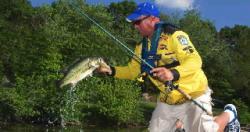Post
Don’t Overlook Small Swim Baits
Fishing Tackle Reviews, Freshwater Fishing Tackle Reviews admin PM

Tournament Pro Bobby Lane has been a fan of swimbaits ever since the day four years ago when a friend showed him how to fish the plastic wobbling, fish-like lures in the lake behind Lane’s home. When his friend hooked the largest bass Lane had ever seen in the lake, the Yamaha Pro was hooked, too.
“They’re amazing lures, they’re easy to use, and autumn is a perfect time to fish them,” explains Lane, who admits he now nearly always has two or three tied on and ready to use no matter where he’s fishing. The 11 pound, 3-ounce largemouth he caught with a swimbait on California’s Clear Lake this past March was the heaviest bass weighed in during the entire 2010 Bassmaster® Elite season.
“Right now, a lot of bass are beginning to move from summer habitat to shallower structure and
cover as baitfish begin their annual migration into the backs of creeks and coves,” he continues. “During this transition, I like to start fishing a small swimbait over points and humps because the lure mimics the forage so well.
“At the same time, swim baits seem to attract slightly larger bass to bite, which is why I prefer to use them instead of a plastic worm or an imitation crawfish. Even though the bass is feeding actively, they’re only feeding once or twice a day, which may be another reason they prefer these slightly larger lures.”
If the Yamaha Pro sees baitfish activity on the surface, he normally uses a swimbait between three and six inches in length. If he’s using a simple, hollow body lure with a turned-down, boot-type tail like those offered by many manufacturers, he rigs with a 3/0 to 5/0 hook and a lightweight. If he’s fishing a lake where bigger bass is more common, he’ll use a larger, pre-rigged swimbait.
“There are dozens of swimbaits on the market today,” explains Lane, “but many of them are very similar in design, so choosing one can be just a matter of preference. I believe bass hit them primarily because of their slow, wobbling action.

Swim Baits: Lots of varieties; find the ones you like using.
“When I’m fishing underwater structures like a submerged hump or a sloping point in less than 10 feet of water, I usually like the swimbait to make contact with the bottom. I’ll use a heavier lure and let it sink, then just start a slow retrieve that touches the bottom every few feet.
“If baitfish are closer to the surface, I’ll fish a lighter swimbait and reel it a little faster.”
Lane believes swimbaits are most effective when fished with a steady retrieve because that’s how baitfish normally swim. They don’t stop and start, dart to one side, or hop up and down, the types of retrieves often used with other lures. Swimbaits, by contrast, are designed to bring feeding strikes more than reaction strikes.
“All you normally want to do is make a long cast and just let the lure appear completely natural as it swims along,” says the Yamaha Pro. “I like to use either a medium-heavy or heavy action rod with a 20-pound fluorocarbon line so I can make long casts and cover a lot of water, and overall my favorite retrieve is one that keeps the lure just a foot or two below the surface.
“The swimming-type tail common to all these types of lures creates plenty of action, even at a slow speed, so you can really attract bass from a long distance. I think a lot of bass follow these lures, too, because I get a lot of strikes close to the boat.”
In tournament competition, Lane frequently uses swimbait to upgrade the quality of his catch after he locates them with other lures. He also uses a swimbait to explore and expand a fishing area where he’s already caught several fish.
In the four years, he’s been seriously fishing and studying swim baits, Lane has learned to match his lure color as closely as possible with the color of the available forage. That’s easier than it sounds, he says, because on lakes throughout the country the primary forage species are shad (silver) and bluegill bream (silver/bluish-black). If he’s fishing dingy water, he’ll also try chartreuse.
“All I can say,” the Yamaha angler concludes, “is that every bass angler owes it to himself to at least try these types of lures on his favorite lake, especially now as bass begin moving to shallow water. Swimbaits are not difficult to use, and once you gain confidence in them, I’m positive you’ll be just like me and have several tied on your rods every time you go fishing.”
